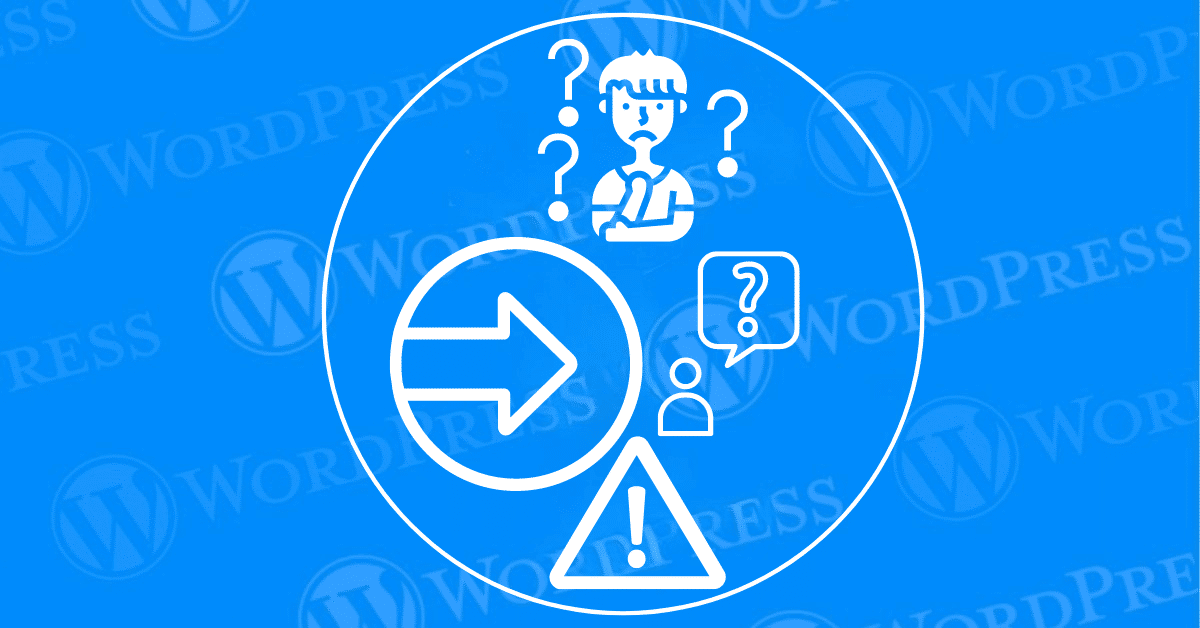WordPress is a powerful and versatile content management. It powers millions of websites worldwide. However, even the most robust platforms can encounter issues. One of the most frustrating problems for users is being constantly logged out. This persistent issue can disrupt your workflow. And hinder your site’s functionality, leading to wasted time and potential revenue loss. That’s why it’s crucial to learn how to fix WordPress logging out problems effectively.
In this tutorial, we’ll explore the reasons behind the “WordPress keeps logging me out” problem. And provide a step-by-step guide to fix WordPress logging out issues. Whether you’re a seasoned WordPress user or a beginner. This guide will help you troubleshoot and fix the issue effectively. Establishing a smoother and more productive experience on your WordPress site.
- Why My WordPress Keeps Logging Me Out?
- Fixing The “WordPress Keeps Logging Me Out” Issue
- How to Identify and Fix Theme Conflicts Causing WordPress Logout Issues
- What Is The Role of a CDN in WordPress Log Out Issues
- How to Troubleshoot Common WordPress Errors (Quick Guide)
- DNS Server Not Responding in WordPress
- How to Fix ERR_CONNECTION_REFUSED in WordPress
- ERR_TOO_MANY_REDIRECTS Error in WordPress
- 502 Bad Gateway Error in WordPress
- How to Fix ERR_CONNECTION_TIMED_OUT in WordPress
- 403 Forbidden Error in WordPress
- 404 Not Found Error in WordPress
- White Screen of Death in WordPress
- How to Fix SSL Certificate Issues in WordPress (‘Your Connection Is Not Private’)
- DNS_PROBE_FINISHED_NXDOMAIN in WordPress
- 405 Method Not Allowed in WordPress
- 401 Unauthorized Error in WordPress
- 400 Bad Request Error in WordPress
- ERR_SSL_PROTOCOL_ERROR in WordPress
- How to Fix 503 Service Unavailable Error in WordPress
- Common SSL Issues in WordPress
- Frequently Asked Questions To Fix WordPress Logging Out Issue
- Conclusion: Fix WordPress Logging Out Issue Easily
Why My WordPress Keeps Logging Me Out?
The “WordPress keeps logging me out” issue can stem from various causes. Often related to browser settings, cache conflicts, incorrect site address configurations, or pluginA plugin is a software component that adds specific features and functionality to your WordPress website. Esse... More conflicts. Understanding these underlying factors is crucial to effectively fix WordPress logging out problems.
When WordPress logs you out repeatedly, it can be due to expired cookies or incorrect cookie settings in your browser. A cluttered cache causing conflicts, mismatched WordPress and site addresses, or plugins that interfere with the login process. By systematically addressing these potential issues, you can pinpoint the root cause and apply the appropriate fix.
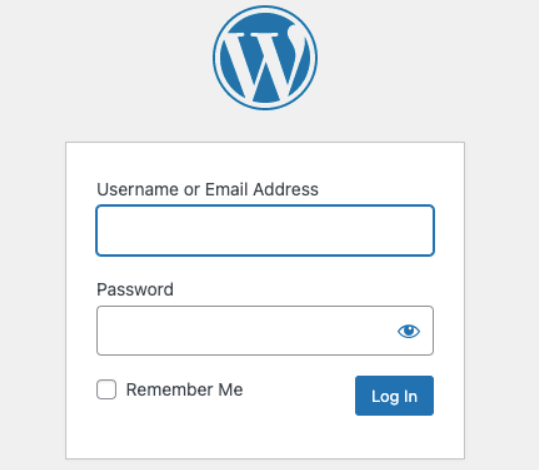
Fixing The “WordPress Keeps Logging Me Out” Issue
Are you frustrated with constantly having to log back into your WordPress site? Fixing the “WordPress keeps logging me out” issue is essential for maintaining a smooth and productive workflow. In this guide, we will explore the common causes of this problem and provide actionable steps to help you fix WordPress logging out issues, ensuring a seamless and uninterrupted experience on your website.

Step 1: Solve Browser-Specific Issues
Often, the issue may lie with your browser settings. Here’s how you can address browser-specific problems to fix WordPress logging out issues:
A. Clear Your Browser’s Cache
Clearing your browser’s cache is a crucial step in maintaining optimal performance and ensuring the most recent version of web pagesIn WordPress, a page is a content type that is used to create non-dynamic pages on a website. Pages are typica... More is loaded. The cache stores temporary files that can sometimes become outdated or corrupted, leading to slow load times and other issues. To clear your browser’s cache, follow these steps:
- Open Browser Settings: Access the settings menuIn WordPress, a menu is a collection of links that are displayed as a navigation menu on a website. Menus are ... More, usually found under the three-dot icon in the top right corner.
- Navigate to Privacy and Security: Look for a section labeled “Privacy and Security” or similar.
- Clear Browsing Data: Select “Clear Browsing Data” and choose the time range for which you want to clear the cache. It’s often best to select “All time” for a thorough clean.
- Select Cached Images and Files: Ensure that the option for “Cached images and files” is checked.
- Clear Data: Click the “Clear data” button to remove the cached files.
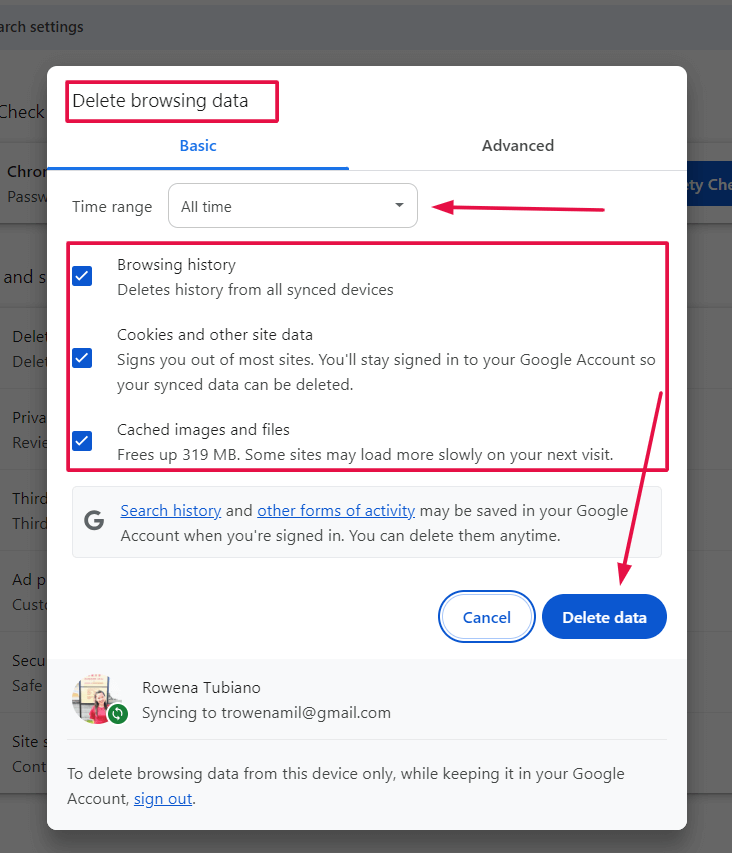
Regularly clearing your cache can help resolve website display issues and improve overall browsing speed.
How to Clear Cache in Popular Browsers
Is your browser behaving oddly? One common troubleshooting step is to clear your cache. This process removes stored web data, which helps in loading pages quicker but can sometimes cause issues if outdated. Here’s a quick guide on how to do it in four major browsers.
Chrome
- Access Settings: Click on the menu icon (three dots) in the top-right corner.
- Clear Browsing Data: Navigate to “More tools” and then select “Clear browsing data.”
- Choose Time Range: Set the time range to clear. For a complete clear-out, select “All time.”
- Select Cached Content: Check “Cached images and files.”
- Clear Data: Click “Clear data” to finish.
Firefox
- Open Preferences: Click on the menu button (three horizontal lines) and select “Preferences.”
- Privacy & Security: Choose this option from the left menu.
- Clear Data: In the “Cookies and Site Data” section, click “Clear Data.”
- Deselect Cookies: Ensure only “Cached Web Content” is selected if you don’t wish to clear cookies.
- Execute Clear: Press “Clear” to remove the cache.
Safari
- Access Settings: Click “Safari” in the menu bar at the top, then select “Preferences.”
- Choose Privacy: In the preferences window, click on “Privacy.”
- Manage Data: Select “Manage Website Data” to view stored content.
- Remove Cache: Choose specific sites to clear or “Remove All” for a complete clear-out.
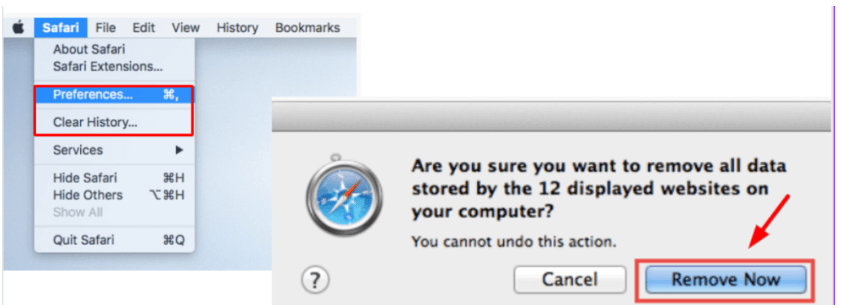
Microsoft Edge
- Open Settings: Access settings via the menu (three dots) in the top-right corner.
- Privacy & Services: Click on “Privacy, search, and services.”
- Clear Browsing Data: Locate the “Clear browsing data” section and select “Choose what to clear.”
- Select Checks: Ensure “Cached images and files” is ticked.
- Final Step: Hit “Clear now” to delete the cache.
By following these steps, you can easily refresh your browser’s performance across different platforms. It’s a simple fix that can resolve many common browsing issues.
B. Clear Your Browser’s Cookies
Cookies are small pieces of data stored by websites to remember your preferences and login information. However, they can sometimes cause issues if they become outdated or corrupted. To clear your browser’s cookies, follow these steps:
- Open Browser Settings: Access the settings menu, typically found under the three-dot icon in the top right corner.
- Navigate to Privacy and Security: Look for the section labeled “Privacy and Security” or something similar.
- Clear Browsing Data: Select “Clear Browsing Data.”
- Select Cookies and Other Site Data: Make sure the option for “Cookies and other site data” is checked.
- Clear Data: Click the “Clear data” button to remove the cookies.

Clearing cookies can resolve login problems and prevent websites from tracking your browsing behavior.
C. Check Your Browser’s Settings
Ensuring your browser settings are configured correctly can prevent a range of issues, including those related to security, privacy, and performance. Here’s how to check your browser’s settings:
- Access Settings Menu: Click the three-dot icon in the top right corner to open the settings menu.
- Review Privacy and Security Settings: Navigate to the “Privacy and Security” section. Here, you can adjust settings related to cookies, site data, and permissions.
- Enable Necessary Features: Ensure that features like JavaScript and pop-ups are enabled if needed by specific websites.
- Update Browser: Make sure your browser is up to date. Outdated browsers can have compatibility issues and security vulnerabilities.
- Reset Settings if Needed: If you’re experiencing persistent issues, consider resetting your browser settings to their default configuration.
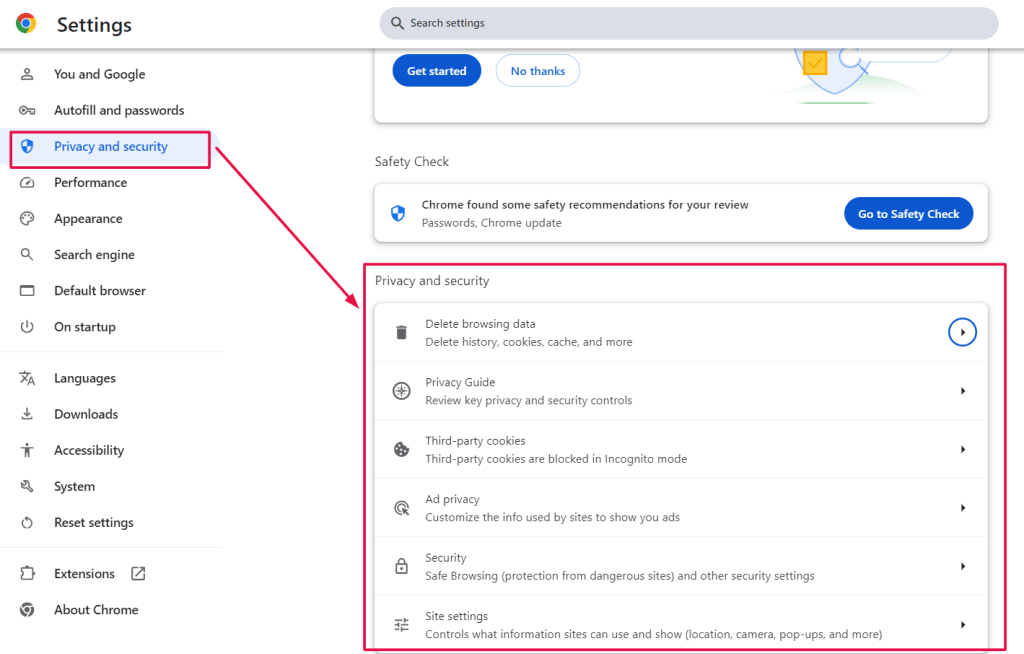
Regularly checking and updating your browser’s settings can help maintain a smooth and secure browsing experience.
Step 2: Clear The Cache of Your WordPress Site
A cluttered site cache can cause various issues, including persistent logouts. Here’s how to clear your WordPress site cache to fix WordPress logging out:
1. Clear Browser Cache: Besides clearing cookies, clearing the cache can also help. This ensures that you’re loading the most recent version of your WordPress site.
2. Clear Cache from Caching Plugins: If you’re using caching plugins like W3 Total Cache or WP Super Cache, clear the cache through the plugin settings. This can resolve conflicts that may be causing the logout issue.
Step 3: Check Your WordPress Site Address To Fix The Login Issue
A mismatch between your WordPress Address (URL) and Site Address (URL) can lead to login issues. Here’s how to check and correct these settings to fix WordPress logging out:
1. Navigate to General Settings: Go to your WordPress dashboardIn WordPress, the Dashboard is a central hub for managing a website's content and settings. It is the first sc... More, then Settings > General.
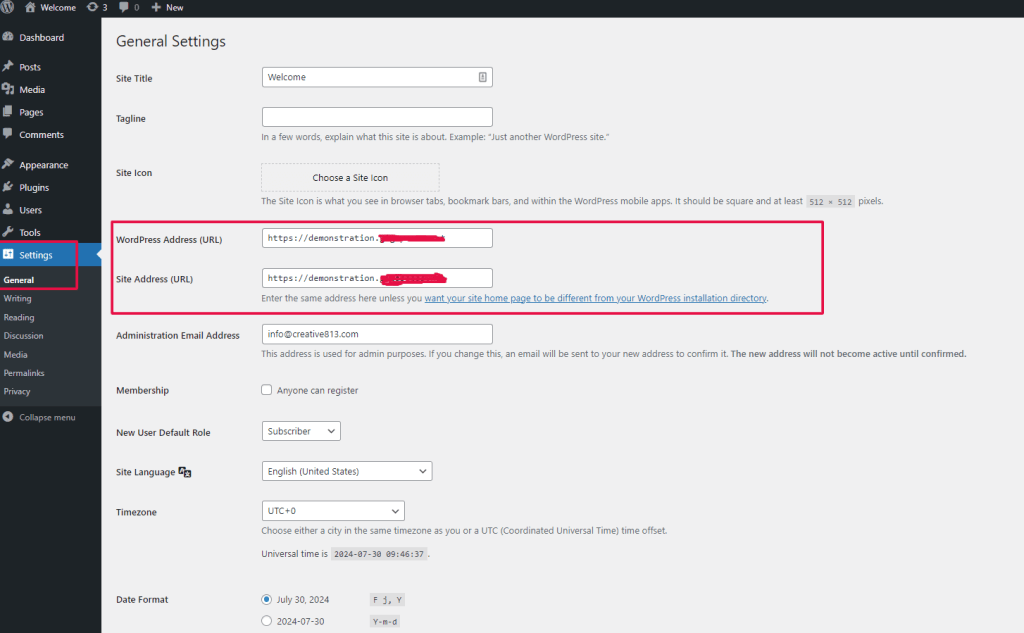
2. Verify URLs: Ensure that both the WordPress Address (URL) and Site Address (URL) are correct and match. If they don’t, update them accordingly.
Understanding the WordPress URL Mismatch Issue
A common frustration for WordPress users is being unexpectedly logged out of their site. This often occurs because of a mismatch between the WordPress site address and the URL stored in the login session cookies. Such discrepancies typically arise after changing your domain name or adding an SSL certificate, which might lead to outdated URLs in your WordPress settings.
Identifying the Problem
To inspect this issue, log into your WordPress dashboard and navigate to Settings > General. Here, you’ll find two crucial fields:
- WordPress Address (URL)
- Site Address (URL)
The WordPress Address specifies where your WordPress files reside, while the Site Address is the URL users will type to access your site.
Ensuring these two URLs match is essential. Inconsistencies can cause WordPress to automatically log you out. If you notice a difference, simply update the URLs to align with one another right within the settings. Opt for either “http://www.yourdomain.com” or “http://yourdomain.com,” depending on your branding preferences. Don’t forget to save any changes you make.
Making Changes When You Can’t Access the Dashboard
If you’re unable to make changes directly due to frequent logouts, you may need a more hands-on approach.
- Accessing the File System: Use a Secure File Transfer Protocol (SFTP) client like FileZilla to access your site’s files. Connect to your server and locate the
wp-config.phpfile within your domain’s root directory. - Editing the wp-config.php File: Open the
wp-config.phpfile, and add the following lines of code, replacing the placeholder URL with your own domain:define('WP_HOME', 'http://yourdomain.com'); define('WP_SITEURL', 'http://yourdomain.com'); - Save and Close: After inserting the lines, save the file and close your SFTP client.
With these changes, revisit your WordPress dashboard. If the issue was related to URL mismatches, the problem should now be resolved. This method effectively aligns your site addresses, ensuring smooth, uninterrupted access.
Step 4: Disable Plugins to Identify Conflicts
Plugins can sometimes cause conflicts leading to repeated logouts. Here’s how to identify and fix plugin-related issues to fix WordPress logging out:
1. Deactivate All Plugins: Temporarily deactivate all your plugins from the Plugins menu in your WordPress dashboard.
2. Reactivate Plugins One by One: Reactivate each plugin one at a time and test your login status after each activation. This will help you identify which plugin is causing the issue.
3. Update or Replace Conflicting Plugins: Once you’ve identified the problematic plugin, check for updates or consider replacing it with a similar, more reliable plugin.
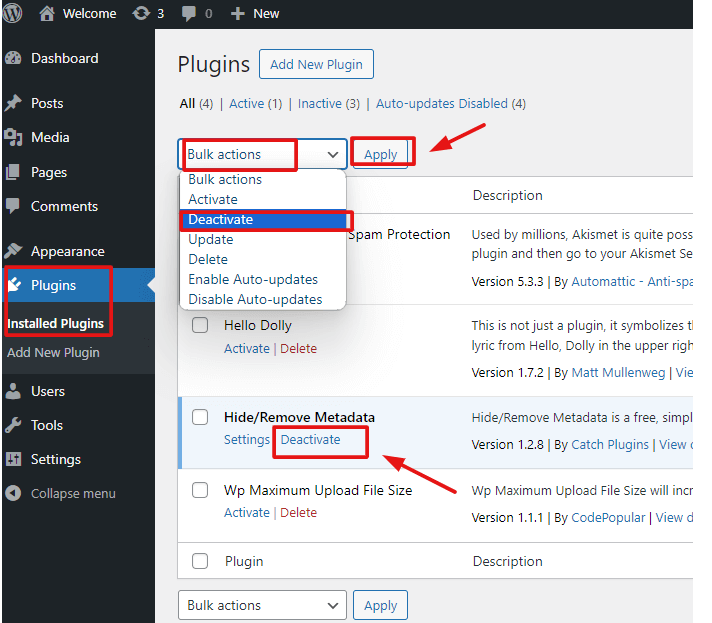
How to Identify and Fix Theme Conflicts Causing WordPress Logout Issues
Are you experiencing frequent WordPress logout issues? It’s possible that a theme conflict could be at the root of the problem. In this guide, we’ll walk you through how to troubleshoot and resolve theme conflicts in WordPress, ensuring your site runs smoothly and without interruptions.
Identify and Isolate Suspect Themes
WordPress offers a vast selection of themes, but not all are created with high-quality code. Poorly coded themes can lead to conflicts, often causing frustrating logout issues in WordPress. If you’ve recently installed or updated a theme, it’s worth investigating whether it’s the culprit. Identifying and isolating problematic themes is the first step in fixing WordPress logout issues caused by theme conflicts.
Steps to Identify Theme Conflicts in WordPress:
- Review Recently Installed Themes: If you notice logout issues after installing a new theme, that theme may be the cause.
- Check for Recent Theme Updates: Sometimes, updates to a theme can introduce new bugs or conflicts. Always check for recent changes.

Revert to a Default WordPress Theme
One of the quickest ways to determine if your theme is causing logout issues is to switch back to a default WordPress theme, such as Twenty Twenty-Three or earlier versions. Default themes are optimized and less likely to cause conflicts. Here’s how to revert to a default theme:
How to Switch to a Default Theme:
- Log into Your WordPress Dashboard.
- Navigate to Appearance > Themes.
- Activate a Default Theme: Activate a default theme, such as Twenty Twenty-Three, by clicking Activate.
- Reinstall if Necessary: If you previously uninstalled the default theme, you’ll need to reinstall it from the WordPress theme repository.
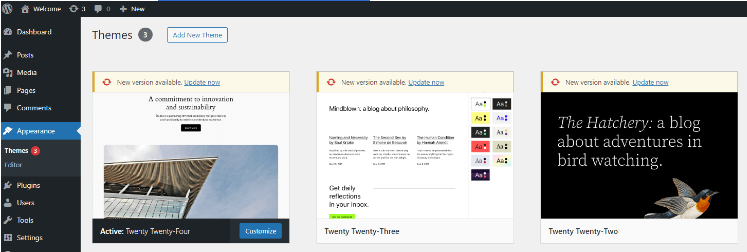
Switching to a default theme can help determine if your current theme is the source of the WordPress logout problem.
Update Your WordPress ThemesA WordPress theme is a set of files that determine the design and layout of a website. It controls everything ... More
Before assuming a theme conflict is the issue, it’s essential to ensure that all your themes are up-to-date. Outdated themes can cause compatibility problems and lead to logout errors in WordPress. Always check for available theme updates:
How to Update Themes:
- Check for Notifications: In your WordPress dashboard, look for any update notifications under Appearance > Themes or the Updates section on the left-hand side.
- Apply the Updates: Apply any available updates to the theme, which may resolve existing bugs or conflicts causing logout issues.
By keeping your WordPress themes updated, you reduce the risk of encountering logout problems and other conflicts.
Test for Theme Conflicts by Logging Out and Back In
Once you’ve activated a new or default theme, test whether the logout issue persists. Simply log out of your WordPress site, then log back in to see if the issue is resolved. If switching themes fixes the problem, the conflict likely stems from your previous theme.
Steps to Test for Theme Conflicts:
- Log out of your WordPress site.
- Log back in after activating the default theme.
- If the issue no longer occurs, your original theme was likely responsible for the conflict.
Evaluate Theme Quality Before Installation
To prevent future WordPress logout issues caused by theme conflicts, it’s important to evaluate the quality of a theme before installing it. Themes with poor user reviews or low ratings are more likely to cause problems.
How to Assess Theme Quality:
- Visit the WordPress Theme Directory: Search for the theme by name.
- Check User Ratings and Reviews: Look at the ratings and reviews to identify any potential issues. Higher-rated themes with positive feedback are generally more reliable.
- Detailed Reviews: Click on See All to read detailed user reviews, which can give you a better idea of the theme’s reliability and history of conflicts.
By thoroughly evaluating themes before installation, you can avoid potential logout issues and other conflicts in the future.
What Is The Role of a CDN in WordPress Log Out Issues
A Content Delivery Network (CDN) plays a crucial role in enhancing the performance and speed of your WordPress site by distributing content across servers worldwide. By caching your website’s data closer to users, a CDN helps reduce latency and improve load times. However, there are instances where the CDN cache may lead to unexpected WordPress login issues, such as being logged out unexpectedly. This guide will explore how CDNs affect WordPress sessions and provide solutions for resolving these issues.
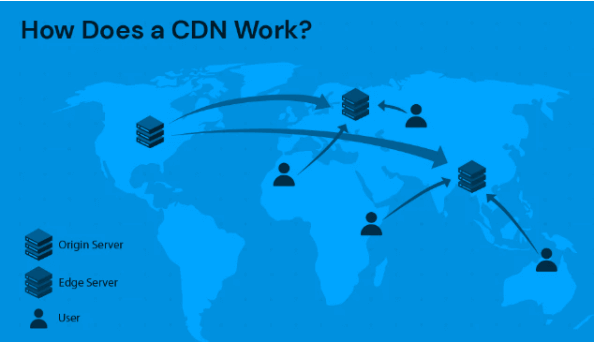
How CDNs Affect WordPress Sessions
A CDN cache stores versions of your website data to accelerate page load times for visitors. However, if the cache becomes outdated or corrupted, it can interfere with WordPress login sessions, causing you to be logged out repeatedly. This happens because the cached session data stored by the CDN may not align with the live session data expected by your browser, resulting in conflicts during authentication.
Steps to Clear Your CDN Cache and Resolve WordPress Login Issues
One of the most effective ways to resolve WordPress login issues caused by CDNs is to clear the CDN cache. Below are step-by-step instructions on how to do this:
Using a Caching Plugin to Clear CDN Cache
Many WordPress caching plugins offer seamless integration with CDNs, allowing you to manage and clear cache directly from your WordPress dashboard. Here’s how to use a popular plugin like W3 Total Cache to clear your CDN cache:
- Navigate to Plugin Settings: From your WordPress dashboard, go to the plugin’s settings. In the case of W3 Total Cache, look for the tab labeled “CDN.”
- Purge Specific Items: If you only want to clear certain cached files, select Purge Specific Items. This allows you to target specific outdated content without clearing everything.
- Purge All Cached Content: To completely reset the CDN cache and eliminate any conflicts causing the login issues, select Purge All. This option clears all cached data across the CDN.
By keeping your CDN cache clear and up to date, you can avoid many WordPress session-related issues and improve the overall performance of your website.
Clearing CDN Cache Without a Plugin
If you prefer not to use a plugin, or if your current setup doesn’t support one, you can clear the CDN cache manually through your CDN provider’s interface. Here’s what to do:

- Contact Your CDN Provider: Most CDN providers, such as Cloudflare or StackPath, offer the option to clear cache via their dashboard. Contact their support team or check their documentation for detailed instructions.
- Manually Clear Cache: Log in to your CDN provider’s dashboard and navigate to the caching section. Look for options to either clear specific cached content or purge all.
By regularly clearing the CDN cache, you can minimize WordPress login issues and ensure that your users experience a smooth and uninterrupted browsing experience.
Keeping Your CDN Aligned with Your WordPress Site
Managing your CDN cache effectively is key to resolving WordPress login issues and maintaining optimal site performance. Whether you use a caching plugin or clear the cache manually, keeping the cache in sync with your current WordPress data is crucial to preventing session conflicts and minimizing disruptions. By taking proactive steps to clear and update your CDN cache, you can ensure that your WordPress site runs smoothly and securely for both you and your visitors.
How to Troubleshoot Common WordPress Errors (Quick Guide)
When managing a WordPress site, running into technical issues can be frustrating. However, the good news is that most of these common WordPress errors have well-documented solutions. In this comprehensive guide, we’ll walk you through frequent WordPress issues and how to fix them.
DNS Server Not Responding in WordPress
If you’re seeing a DNS Server Not Responding error, here’s how to troubleshoot:
Solution: Begin by checking your internet connection and restarting your router. You can also try flushing your DNS cache or switching to a public DNS server like Google’s (8.8.8.8 and 8.8.4.4).
How to Fix ERR_CONNECTION_REFUSED in WordPress
The ERR_CONNECTION_REFUSED error typically indicates that your browser was unable to connect to the site’s server.
Solution: First, verify your firewall settings to ensure the website isn’t blocked. Clearing your browser cache and trying a different browser can also help resolve the issue.
ERR_TOO_MANY_REDIRECTS Error in WordPress
The ERR_TOO_MANY_REDIRECTS error often happens due to conflicting redirect settings.
Solution: Start by clearing your browser’s cookies and cache. Then, check your WordPress URL settings for any conflicts. If you’re using redirect plugins, make sure there aren’t any redirect loops.
502 Bad Gateway Error in WordPress
A 502 Bad Gateway error can happen when your site’s server receives an invalid response from another server.

Solution: Simply reloading the page or waiting a few minutes often resolves this temporary error. If it persists, contact your hosting provider to check for server issues.
How to Fix ERR_CONNECTION_TIMED_OUT in WordPress
The ERR_CONNECTION_TIMED_OUT error usually means your website is taking too long to respond.
Solution: Increase the PHP memory limit by editing your wp-config.php file. You should also try deactivating plugins and themes to identify any that may be causing the problem.
403 Forbidden Error in WordPress
A 403 Forbidden Error occurs when the server denies access to a specific page or resource.
Solution: Review the permissions settings in your .htaccess file and ensure that your IP addressAn IP Address (Internet Protocol Address) is a unique numerical identifier assigned to every device connected ... More hasn’t been blacklisted by the server.
404 Not Found Error in WordPress
The 404 Not Found error happens when the server can’t find the requested URL.
Solution: Check your permalinkIn WordPress, a permalink is a permanent URL that points to a specific post or page on a website. It is the we... More settings and ensure they match your desired URL structure. Updating your .htaccess file can also resolve this issue.
White Screen of Death in WordPress
The White Screen of Death is one of the most dreaded errors in WordPress, leaving you with a blank page.

Solution: Increase the PHP memory limit and disable plugins to find out which one might be causing the issue. Also, look at any recent changes to themes or plugins that could be responsible.
How to Fix SSL Certificate Issues in WordPress (‘Your Connection Is Not Private’)
SSL certificate issues are critical for WordPress sites, as they impact security and SEO.
Solution: Ensure your SSL certificate is properly installed and up to date. Use a tool like SSL Checker to confirm that your SSL configuration is correct.
DNS_PROBE_FINISHED_NXDOMAIN in WordPress
The DNS_PROBE_FINISHED_NXDOMAIN error typically points to a problem with your DNS settings.
Solution: Verify your DNS settings and clear the DNS cache. Restarting your Network Stack via the command prompt may also resolve this issue.
405 Method Not Allowed in WordPress
A 405 Method Not Allowed error happens when the server doesn’t support the request method used.

Solution: Check your server’s configuration and the request method being used. If you’re using custom scripts, ensure they support the same request method.
401 Unauthorized Error in WordPress
A 401 Unauthorized error occurs when there’s an authentication problem.
Solution: Confirm that your login credentials are correct. Also, check the server’s authentication configurations and try reconfiguring the .htaccess file if needed.
400 Bad Request Error in WordPress
The 400 Bad Request error can happen due to malformed URLs or invalid requests.
Solution: Clearing the browser cache and cookies often resolves this issue. Additionally, check for incorrect URLs and reduce the file upload size if necessary.
ERR_SSL_PROTOCOL_ERROR in WordPress
The ERR_SSL_PROTOCOL_ERROR typically indicates a problem with your SSL settings.
Solution: Clear your browser cache and make sure your system’s date and time are correct. Resetting your SSL settings in the browser may also help.
How to Fix 503 Service Unavailable Error in WordPress
The 503 Service Unavailable error can happen when your server is temporarily overloaded.

Solution: Wait a few minutes and then reload the page. If the error persists, try deactivating plugins and switching themes to isolate the issue.
Common SSL Issues in WordPress
SSL issues can impact the security and SEO of your WordPress site.
Solution: Ensure your SSL certificate is properly installed and configured. Also, check that all your plugins and themes are compatible with SSL. If you’re experiencing issues, tools like Really Simple SSL can help resolve them.
Having a clear understanding of these frequent problems. And how to resolve them will make site management smoother. Always remember to maintain regular backups of your site. This will be invaluable when troubleshooting these common WordPress issues.
Frequently Asked Questions To Fix WordPress Logging Out Issue
Q: Why does clearing my browser cookies and cache help with login issues?
A: Clearing cookies and cache can resolve conflicts caused by outdated or corrupted data stored by your browser, ensuring that your login sessions are correctly recognized by WordPress.
Q: Can outdated themes or WordPress versions cause logout issues?
A: Yes, using outdated themes or WordPress versions can cause compatibility issues and security vulnerabilities, potentially leading to login problems. Always keep your WordPress installation and themes up to date.
Q: How do I know if a plugin is causing the logout issue?
A: By deactivating all plugins and reactivating them one by one, you can identify if a specific plugin is causing the issue. If the logout problem stops when a particular plugin is deactivated, that plugin is likely the culprit.
Conclusion: Fix WordPress Logging Out Issue Easily
Dealing with the “WordPress keeps logging me out” issue can be frustrating. But with a systematic approach, you can identify and resolve the underlying causes. By addressing browser-specific issues. Clearing your WordPress cache, verifying your site address, and checking for plugin conflicts. You can effectively fix WordPress logging out issues. And secure a more stable and reliable login experience.
Remember, maintaining your WordPress site involves regular updates. Monitoring for conflicts, and ensuring that your site settings are correctly configured. By following these best practices. You can minimize disruptions and enjoy a seamless WordPress experience. Allowing you to focus on creating and managing your content effectively.
If you’re struggling to Fix WordPress Logging Out and want a hassle-free solution, explore our fast WordPress hosting with done-for-you updates. Check out our hosting packages by clicking the button below:

